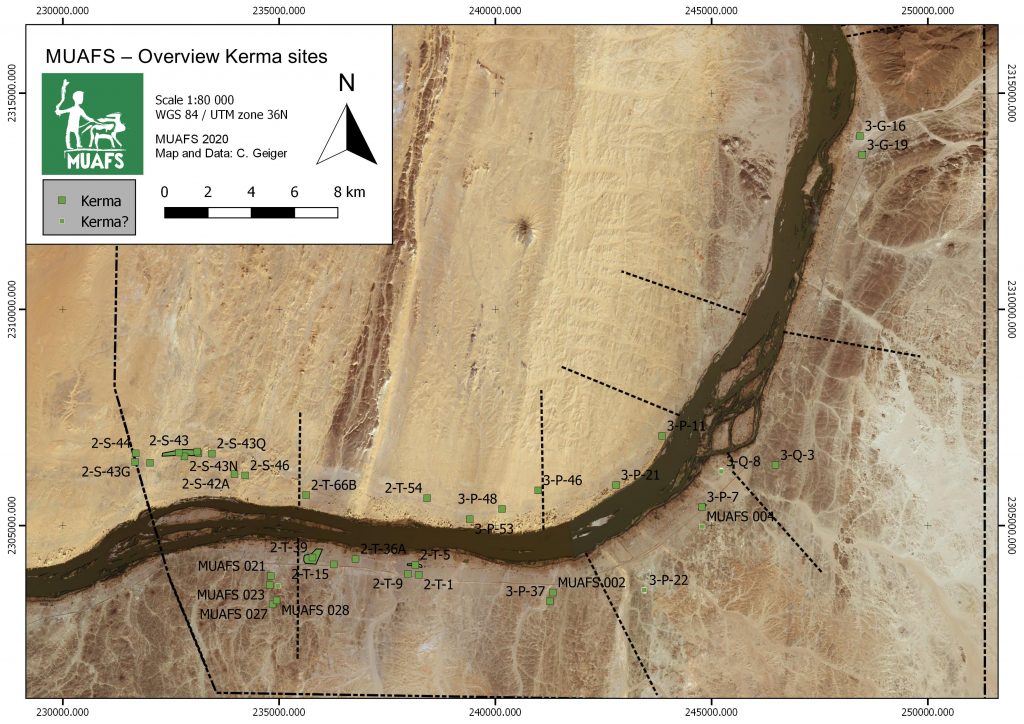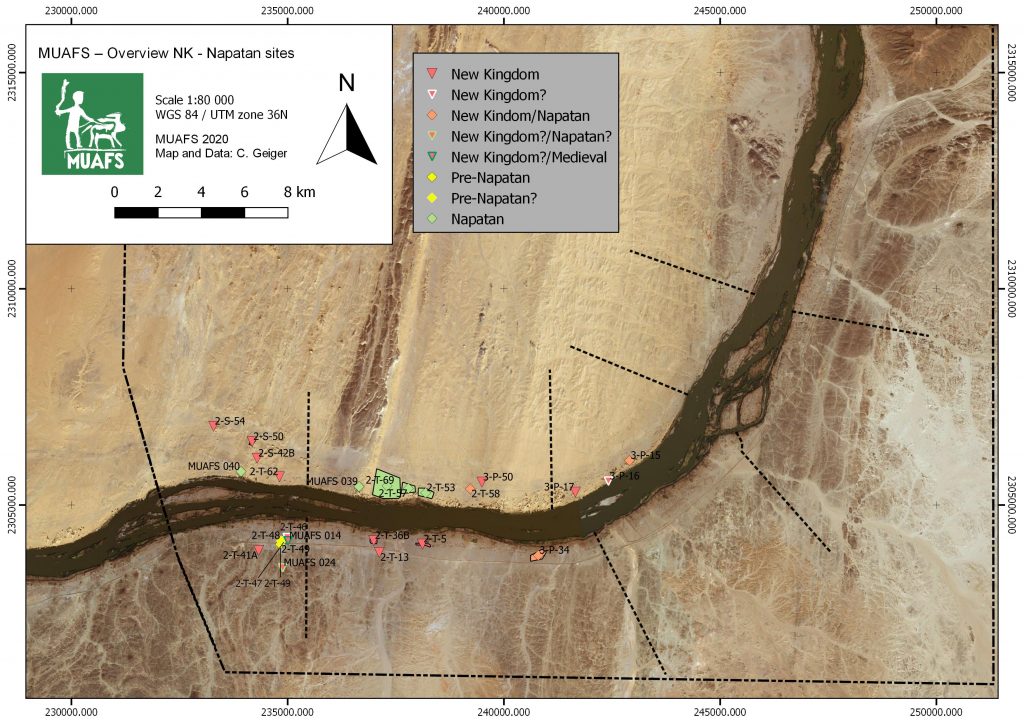After the recent blog posts by my colleagues Rennan Lemos and Giulia D’Ercole presenting their tasks within Work Package 2 and Work Package 3 I am not only happy to introduce Work Package 1: The variability of domestic architecture in the Attab to Ferka region I am – together with our PI Julia Budka – responsible for, but also to write my first blog entry as a member of the ERC Consolidator Grant project DiverseNile. This especially, since I already could join the previous ERC Starting Grant project AcrossBorders of Julia Budka for its last year at the end of 2017, leaving Berlin and moving to Munich, which – as a Tyrolean – felt a bit like coming home.
My first contact with Sudan, which I immediately fell in love with, while working in Hamadab/Meroe and Musawwarat es-Sufra, was very long ago in 2003. But also my first visit to the region between the Second and Third Cataract – and here specifically to Sai Island with its impressive New Kingdom town – dates some years back to 2012.
At Sai Island, especially by the AcrossBorders project or at the neighbouring town Amara West (Spencer et al. 2017), the research of the recent years concerning the manifold relations between the Egyptians and the Nubians in the Middle Nile already moved towards a more differentiated approach with implementing the concept of ‘cultural entanglement’ (see van Pelt 2013 with references). The focus of work at sites like Sai and Amara being administrative centres in New Kingdom Nubia was necessarily set on the official and elite sphere.
The DiverseNile project investigating the Attab to Ferka region now goes a step further aiming to throw light on the peripheries still very much standing in the shadows of the powerful urban sites. Shifting the focus towards the hinterland not only broadens our horizon filling the still significant voids of research in this region of the Nile valley but very much promises to give a new and deeper insight in the cultural diversity of people living in the hinterland of towns, their interactions and possible more autonomous living situations – as these aspects become archaeologically more visible aside official power throughout the rich cultural history of Nubia.
In this regard WP 1 aims to contribute to a better understanding of the occupants of the Attab to Ferka region, their cultural identities and interactions, their social structures or complexity through investigating the diverse settlement sites, their variability and development and thus their spatial and temporal frame. Concerning the latter our focus lies on Bronze Age Nubia, a term introduced by our PI reflecting the need to have a more differentiated look at the so far used categories ‘Nubian’ or ‘Egyptian’ during the Kerma and the Egyptian Second Intermediate and New Kingdom Periods in Nubia and thus an era with multiple upheavals. This need became also clear studying the previously classifications attributed to the diverse archaeological remains in this part of the Middle Nile valley.
In this respect the region of our interest was previously and firstly surveyed by the Sudan Antiquities Service together with the French Archaeological Research Unit in the 1970ies directed by A. Vila and resulting in several Volumes. These works serve as very important input for our research, as Vila and his team impressively discovered and documented 219 sites from Palaeolithic to Medieval times. Among these, sites qualified by Vila as Kerma and New Kingdom remains were represented both at around 7% on the right and with a larger number at 12.4% resp. 16.9% on the left riverbanks, the latter consisting predominantly of settlement sites.

Among all of the sites listed by Vila a total of 138 sites could be successfully re-identified during our two MUAFS seasons in 2018/2019 and at the beginning of this year, shortly before Covid-19 became the new reality (for further details see the online reports as well as Budka 2019). As an fascinating example for an Egyptian New Kingdom domestic site comprising evidence for Kerma presence too, GiE 001 (Vila’s site NF-36-M/2-T-36B), can be emphasized here, where a test excavation was started in 2020, which we will hopefully further pursue next year.

Although Covid-19 has restricted us to office work, it has not limited us to carry out our research or staying in contact with our Sudanese colleagues and friends. Re-planning rather is giving us the possibility not only to evaluate the already gained data and information but also to engage with the topic in depth. In this regard I am currently not only further screening sites of our interest indicated by Vila, analysing his approach and state of documentation, but also their distribution within our concession area. Concerning the latter the examination of similar situations of periphery within frontier zones like for example the Third Cataract (Edwards 2012) and a deeper study of other rural Kerma villages like Gism el-Arba (Gratien 2003) yields a very fruitful input for our questionings in many ways. As I dealt a lot with Kushite sacral architecture in the last years doing my PhD, I am especially happy to explore architectural remains aside of the official sphere telling a lot of different and lesser known stories. In this regard – as my next blog entry will address Kerma types of domestic architecture and building techniques – keep reading here in our space!
References
Budka, J. 2019 (with contributions by G. D’Ercole, C. Geiger, V. Hinterhuber and M. Scheiblecker). Towards Middle Nile Biographies: the Munich University Attab to Ferka Survey Project 2018/2019. Sudan & Nubia 23, 13–26.
Edwards, D. N. 2012. ‘The Third-Second Millennia BC. Kerma and New Kingdom Settlements’, in A. Osman and D. N. Edwards (eds), Archaeology of a Nubian frontier. Survey on the Nile Third Cataract, Sudan. Leicester, 59–87.
Gratien, B., S. Marchi, O. Thuriot, and J.-M. Willot 2003. ‘Gism el- Arba, habitat 2. Rapport préliminaire sur un centre de stockage Kerma au bord du Nil’. Cahiers de Recherches de l’Institut de Papyrologie et d’Égyptologie de Lille 23, 29–43.
Spencer, N., Stevens, A. and Binder, M. 2017. Introduction: History and historiography of a colonial entanglement, and the shaping of new archaeologies for Nubia in the New Kingdom, 1‒61, in: N. Spencer, A. Stevens and M. Binder (eds.), Nubia in the New Kingdom. Lived Experience, Pharaonic Control and Indigenous Traditions. British Museum Publications on Egypt and Sudan 3. Leuven.
Van Pelt, W.P. 2013. Revising Egypto-Nubian Relations in New Kingdom Lower Nubia: From Egyptianization to Cultural Entanglement. Cambridge Archaeological Journal 23.3, 523‒550.
